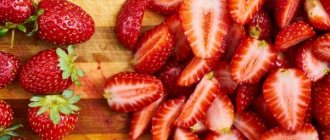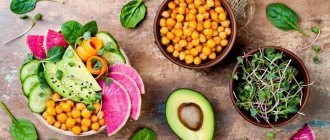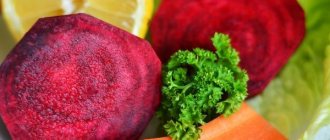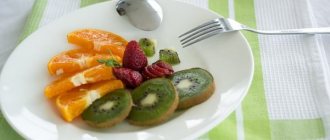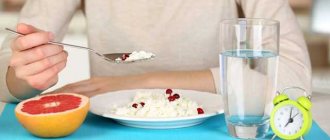The principle of the fruit and vegetable diet
The main principle of the fruit and vegetable diet is to eat only vegetables and fruits.
They can be raw, boiled, steamed, baked in the oven. Basic moments:
- The main rule is not to season them with salt and spices , and also not to add oil.
- It is allowed to eat dried fruits in small quantities - raisins, prunes, dried apples and pears, dates and dried apricots.
- Nutritionists allow consuming fruits and vegetables before bed , but not all of them, only low-calorie ones. In this case, the food should be eaten fresh; boiled and baked vegetables and fruits have a higher calorie content.
- Consuming large amounts of fluid while dieting.
- You can eat all known and available vegetables and fruits. It is recommended not to overuse vegetables with a high starch content. These include: radishes, potatoes, green peas, carrots and corn. Also, do not get carried away with high-calorie fruits: bananas, grapes, watermelons and persimmons.
There is a variety of fruit and vegetable diets in which you do not have to give up meat and fish, but in small quantities.
Peculiarities
The diet is easily tolerated by both young people and the elderly. This is due to the fact that it has weak restrictions on the number of meals and volumes of food consumed.
Peculiarities:
- This diet is short-lived; you should not stay on it for more than 7-10 days , since vegetables and fruits do not contain the animal fats and proteins necessary for the body.
- During the diet, foods with fast carbohydrates are not consumed , but foods with slow carbohydrates remain. They help break down proteins, thereby providing the body with energy.
- Complex carbohydrates contribute to long-term saturation of the body , improving overall well-being, but with a long period of their consumption.
- The diet is also suitable for people with diseases such as osteoporosis. With this disease, the body needs the daily requirement of calcium and a number of other microelements and vitamins, which helps strengthen bones.
Among the foods with slow carbohydrates are:
- dill, parsley, lettuce;
- cabbage, onions, tomatoes, bell peppers, zucchini;
- cherries, plums, oranges, apples, peaches, pears.
- blueberries, blackberries, red and black currants, sea buckthorn, strawberries and strawberries.
Is it possible to lose weight on fruits and vegetables?
Fruits and vegetables are low in calories, so the body has to use more of its own energy when digesting them than it gets from the product.
They contain plant fiber that is not digested in the body. But it creates a feeling of fullness for a long period, thereby not forcing a person to eat frequently.
Reducing the consumption of this element leads to the fact that the body is forced to spend its own accumulated energy. It is worth noting the ability of some fruits and vegetables to burn fat. Here you can highlight grapefruit, kiwi, orange, watermelon, as well as cucumber, cabbage and pumpkin.
Undigested fiber enters the intestines and, thanks to its granular structure, absorbs waste and toxins. Removes them from the body and cleanses the intestines. Vegetables and fruits increase the acidity of gastric juice, thereby stimulating its active secretion. They are distinguished by their low carbohydrate content.
All this proves that by using fruits and vegetables in the main diet, you can improve the digestion process and significantly lose weight without harm to your health.
The second day of the diet is vegetable
The second day of the diet is vegetable, and you can eat both raw and boiled vegetables. You can add a little pepper and salt to salads and soups, but butter, milk and cream should not be used in cooking.
For breakfast, it is recommended to eat boiled potatoes, which are a source of many vitamins and essential minerals (calcium, potassium, phosphorus and iron).
For salads, it is best to use lettuce, cabbage, onions, carrots, radishes, cucumbers, celery and broccoli. The salad should be seasoned with lemon juice, and before eating it, the salad should be kept in the refrigerator for an hour.
Benefits of diet
What are the benefits of a fruit and vegetable diet:
- cleansing the intestines of waste and toxins - the digestion process is improved;
- normalization of metabolism;
- increased immunity due to the content of vitamins and microelements;
- normalization of gastric acidity;
- strengthens the walls of blood vessels, regulates cholesterol levels and helps cleanse the blood;
- normalizes blood pressure;
- improving the color and structure of the skin of the face and body, strengthening hair and nails;
- improved sleep and a feeling of lightness within the body;
- reducing a person’s weight – the load on the legs and circulatory system is reduced.
Advantages
The main advantages of a fruit and vegetable diet are:
- multiple free meal regimens, compared to other diets, are easier to tolerate by the body;
- easy to prepare, you don’t have to cook – just use the ingredients raw;
- the main thing is a tasty diet.
Flaws
The main disadvantage of the diet is that the body does not receive protein, which is involved in the construction of cells, and as a result:
- possible loss of strength and energy, poor performance;
- may cause bad mood and irritability;
- loose stools or even diarrhea may occur;
- may cause increased drowsiness.
Rules
I would like to note a large number of rules when following a fruit and vegetable diet:
- consume about 1.5 kg of fruits per day , 300 grams per meal, for a total of 5 meals per day;
- During the day, eat more vegetables than fruits , especially in the evening, vegetables are lower in calories;
- consume more seasonal fresh vegetables and fruits ; try to ensure that the proportion of fresh unprocessed products to thermally processed products is 3:1
- , and fatty foods for the duration of the diet
- do not use mayonnaise, ketchup and oil for dressing salads ; use low-fat kefir, yogurt, lemon juice and vinegar instead;
- drink a lot of water during the day , at least 1.5-2.0 liters;
- do not use salt, pepper and sugar to add flavor to products;
- High calorie fruits are best consumed in the morning;
- use a varied menu , change it constantly during the diet;
- do not consume store-bought juices in tetra packs , sweet carbonated drinks and water;
- green fruits contain less sugar and therefore have less calories;
- add dried fruits to your diet in small quantities.
Dried fruits are great for helping the body cope with diet:
- reduce appetite;
- stimulate brain function;
- protect against stress, which is often caused by diet.
Rules for losing weight
- Try to eat raw fruits and vegetables every day; when cooking, do not fry them, but boil, bake, stew or steam them.
- Limit the use of any types of oils and fats for frying and stewing.
- To quickly burn calories, you should limit your consumption of potatoes, grapes, dates and figs.
- Give preference to tomatoes and eggplants, beets, carrots, peppers, cabbage and pumpkin. It is recommended to include kiwi and apricots, grapefruit, apples and sweet peppers in the menu.
- Fruits with high sugar content are eaten for the 1st or 2nd breakfast. After lunch or before bed, limit your snack to grapefruit, which effectively burns fat and gives the body the necessary energy.
- In the morning, after waking up, limit the consumption of sugar and fast carbohydrates. It is recommended to have breakfast with bran and gray bread, low-fat fermented milk products and eggs.
- Drinking plenty of fluids is beneficial when losing weight. Drink unlimited quantities of water and fresh juices, especially after lunch and in the evening.
The best option is to start a fruit and vegetable fast in the summer, when the heat dulls your appetite and you want to eat something fresh and watery. The warm season is also attractive with an abundance of various vegetables and fruits. In the off-season and winter, products are purchased according to the season or replaced with freshly frozen analogues from the supermarket or your own refrigerator.
Diet products
Allowed
During the fruit and vegetable diet, it is allowed to consume any vegetables and fruits available. But you should approach this selectively and extremely carefully in order to get the desired result.
The following vegetables and fruits are considered dietary:
- cucumbers;
- tomatoes;
- cabbage;
- Bell pepper;
- beet;
- zucchini;
- green leafy vegetables;
- apples;
- plums;
- apricots;
- peaches;
- berries;
- melons;
- spinach and sorrel.
Avoid overuse and limit consumption in the following cases:
- potato;
- green pea;
- radish, radish;
- corn;
- eggplant;
- banana;
- grape;
- kiwi.
Prohibited
Forget completely about consuming during the diet:
- bread and flour products;
- alcohol;
- sugar and sweets;
- jam and jam;
- mayonnaise and dressing sauces;
- chocolate;
- pate and sausages, boiled and smoked sausages;
- fatty types of fish;
- processed cheese;
- sparkling water;
- potato chips and crackers;
- manke.
Reviews of the diet on vegetables and fruits and results
For the most part, reviews of the fruit and vegetable diet are positive and such diets are often used for weight loss.
- “... I start a fruit and vegetable diet towards the end of summer almost every year, when there is a large assortment of vegetables/fruits in stores. Several times I tried to sit exclusively on vegetables and fruits, but I couldn’t stand it. In addition, my doctor friend said that I could kill myself, so I definitely include some protein foods in my diet. Most often fish and cottage cheese, since I’m not indifferent to them, sometimes chicken breast. I am satisfied with the results and well-being during the diet: 3-4 kg per week, while the condition of the skin and hair improves. I recommend".
- “...I tried several times to lose weight on vegetables and fruits. Unfortunately, it doesn't work. Strong feeling of hunger. Therefore, on the advice of a doctor, I switched to a weekly vegetable/fruit fasting day (sometimes 2 days) and have been using this technique for more than 5 years. I’m very happy, I manage to maintain myself and my weight at normal levels.”
Menu for the week
We suggest considering the menu option in the table in the summer with the addition of yogurt:
| Day | Menu |
| 1 | 1 appointment – vegetable salad (cabbage, cucumber, greens) up to 300 gr. You can top it with lemon juice 2nd appointment – green apple or pear, can be cut and put in yogurt Meal 3 – vegetable soup with fried bran bread croutons 2 pcs. Meal 4 – boiled carrots and beets – 1-2 pcs. depending on size Meal 5 – boiled cauliflower, plum for dessert |
| 2 | 1 appointment – portion of baked pumpkin with apples 250 g 2nd appointment – 2-3 pcs. large plums or apricots, can be chopped and put in yogurt Meal 3 – vegetable stew of tomatoes, peppers and tomatoes 300 g Meal 4 – fresh tomatoes and cucumber, chopped and seasoned with vinegar – 250 g Method 5 – baked apples in the oven 2 pcs. |
| 3 | 1 appointment – grated carrots with apple, you can add prunes or raisins, 250 g 2nd appointment – a glass of any fruit juice with bran bread toast Meal 3 – vegetable soup with mushrooms – one serving, fruit mix Meal 4 – fried zucchini 200 g Meal 5 – vegetable salad of tomatoes, cucumbers and sweet peppers with herbs |
| 4 | 1 appointment – vegetable salad (cabbage, cucumber, greens) up to 300 gr. You can top it with lemon juice 2nd appointment – green apple or pear, can be cut and put in yogurt Meal 3 – vegetable soup with fried bran bread croutons 2 pcs. Meal 4 – boiled carrots and beets – 1-2 pcs. depending on size Meal 5 – boiled cauliflower, plum for dessert |
| 5 | 1 appointment – portion of baked pumpkin with apples 250 g 2nd appointment – 2-3 pcs. large plums or apricots, can be chopped and put in yogurt Meal 3 – vegetable stew of tomatoes, peppers and tomatoes 300 g Meal 4 – fresh tomatoes and cucumber, chopped and seasoned with vinegar – 250 g Method 5 – baked apples in the oven 2 pcs. |
| 6 | 1 appointment – grated carrots with apple, you can add prunes or raisins, 250 g 2nd appointment – a glass of any fruit juice with bran bread toast Meal 3 – vegetable soup with mushrooms – one serving, fruit mix Meal 4 – fried zucchini 200 g Meal 5 – vegetable salad of tomatoes, cucumbers and sweet peppers with herbs |
| 7 | 1 appointment – fruit salad with yogurt total weight up to 300 g 2nd appointment – fresh radishes with tomatoes, you can chop everything and season with vinegar Meal 3 – stewed zucchini with tomatoes and peppers 300 g Meal 4 – cherry-apple puree from fresh fruits 250 g Meal 5 – boiled cauliflower and fruit jelly |
Other Diet Options
Protein-vegetable fruit
This is a symbiosis of protein-vegetable and fruit-vegetable diet. It combines alternating vegetables and fruits with protein foods. The best fruits to consume are green apples, citrus fruits, plums and berries.
You can consume these products raw, or you can squeeze fresh juice out of them, grind them into puree or cut salad. It will be very tasty to top it all with low-fat yogurt. Eat significantly more vegetables than fruits. Consume fruits in the morning.
This is a very varied and not strict diet; the number of allowed foods here is increased compared to fruits and vegetables. Lean dietary meat is allowed to be consumed, so it is easily suitable for meat lovers.
The diet is easily tolerated for 3 weeks, and this is its main difference from the fruit and vegetable diet. Avoid eating meat three to four hours before bedtime.
What can you eat with fruits and vegetables on a diet:
- eggs;
- lean meat and fish;
- seafood;
- low-fat kefir and yogurt;
- mushrooms.
We adhere to the rule that food cannot be fried, only boiled, stewed and baked without salt and spices. The remaining rules are the same as the previous fruit and vegetable diet.
Fruits and vegetables + meat
This diet is a subtype of the previous diet and its peculiarity is that every day you need to eat vegetables with a small amount of meat (pork, chicken or turkey). And as a dessert - some delicious fruits.
The meat is consumed thermally processed; try not to fry it. Vegetables are eaten raw, but they can be boiled or baked.
It is recommended to alternate protein days with carbohydrate days. Thus, supplying the body with useful vitamins and microelements and preventing a decrease in muscle mass, which often occurs during other diets.
During this diet, it is recommended to eat dietary meat, preferably chicken breasts or turkey meat. Dietary meat includes not only poultry, but also animals - veal or rabbit.
What to eat:
- daily – 200 grams of meat;
- vegetables – 400 grams;
- porridge, except semolina – 200 grams;
- unsweetened green fruits - 3-4 pieces.
Alcoholic drinks and sweets are strictly prohibited. For other rules and advice, you should refer to the general fruit and vegetable diet.
Fruit and vegetable + kefir
The diet is suitable for lovers of fermented milk products; it is not strict. Using low-fat milk you can prepare cocktails, yoghurts and kefir. Combine vegetables with fermented milk dressings.
It will be very tasty if you add ground fresh fruits and berries to low-fat cottage cheese; also add them to other dairy products. It is allowed to diversify vegetable dishes - stew, squash casserole or vegetable soup.
The menu is very varied with milkshakes with frozen or fresh fruits and berries. With this diet, you are allowed to drink: tea and coffee, various fruit compotes - without sugar, as well as freshly squeezed juices.
The main components of the kefir diet:
- raw vegetables, vegetable soups, salads and sautés;
- kefir, yogurt and various variations of dressings and sauces based on them;
- skim cheese;
- low-fat milk and milkshakes;
- raw fruits.
Fruit and vegetable + porridge
Porridges are considered a storehouse of nutrients and minerals; they contain complex carbohydrates, vegetable proteins and fiber. In order to properly enter the diet, it is recommended to give up fatty foods and sweet desserts 5-6 days before.
It is better to choose coarsely ground cereals for food - not fried or polished, since the shell of the grains stores the largest amount of valuable substances. Before cooking, the cereal must be thoroughly rinsed with water.
It is recommended to keep the grains in water for several hours for quick further cooking. The less the porridge has been subjected to heat treatment, the more valuable it is.
The following are prohibited on this diet:
- bread and products made from it;
- meat and its by-products;
- fish;
- sausage and frankfurters;
- potato;
- chocolate, sugar and sweets;
- milk, butter and other milk products;
The diet is based on the action of fiber, which enters the stomach and ensures long-term satiety. And passing further into the intestines, it cleanses it of toxins and waste. According to the general rules and requirements for fruits and vegetables, everything remains the same as in previous diets.
Menu
The vegetable menu has earned the reputation of being one of the most healthy. The basis for it is the consumption of one and a half kilograms of vegetables in different forms: raw, in the form of salads, soups or stews, in the form of freshly squeezed juices. Sometimes it is allowed to add a small amount of oatmeal or corn flakes to the dish.
For 1 day
To make it easier to create a vegetable diet menu, a one-day option is given.
- Breakfast: salad of grated carrots, oatmeal or corn flakes, dressed with low-fat yogurt.
- Lunch: 2 cucumbers.
- Lunch: mixed vegetables, a slice of rye bread, 2 boiled potatoes with vegetable oil.
- Afternoon snack: red or yellow bell pepper.
- Dinner: a mix of any low-calorie vegetables with olive oil.
Another option
- Breakfast: vegetable salad, 125 g of low-fat cottage cheese, a cup of green tea, a piece of rye bread.
- Lunch: green vegetables (cucumbers, green peas, bell peppers) and 1-2 fruits of your choice.
- Lunch: 150 g of lean meat, a portion of beetroot or okroshka.
- Afternoon snack: 1–2 fruits.
- Dinner: 125 g of low-fat cottage cheese or Zdorovye cheese, mixed vegetables seasoned with lemon juice and olive oil, a piece of rye bread, a glass of natural yogurt without additives.
For 5 days
Weight loss with this diet ranges from 500 to 1000 grams per day.
Daily approximate diet plan
- Breakfast: a cup of biokefir.
- Lunch: the same portion of kefir and 100 g of low-fat cottage cheese.
- Lunch: lettuce with lemon juice and a serving of vegetable soup.
- Dinner: 100 g lean meat and 500 g leafy greens.
For 7 days
Monday
- Breakfast: cabbage and grated apple salad, berry compote.
- Lunch: okroshka, a cup of green tea.
- Afternoon snack: grated carrots with olive oil.
- Dinner: peppers stuffed with tomatoes and eggplants, berry compote.
Tuesday
- Breakfast: a mixture of natural yogurt with a cup of fresh berries.
- Lunch: Greek salad (cucumbers, olives, bell peppers, tomatoes, feta cheese) and jelly.
- Afternoon snack: 2 baked apples.
- Dinner: cabbage broth and a cup of green tea.
Wednesday
- Breakfast: a mix of greens and radishes, a cup of green tea.
- Lunch: basic soup, compote.
- Afternoon snack: baked eggplants.
- Dinner: vegetable stew, dried fruit compote.
Thursday
- Breakfast: cabbage broth and a cup of green tea.
- Lunch: 2 baked potatoes, sauerkraut, a cup of green tea.
- Afternoon snack: boiled grated beets with the addition of prunes.
- Dinner: vegetable salad and a glass of low-fat kefir.
Friday
- Breakfast: natural yogurt and banana.
- Lunch: pea puree, a cup of green tea.
- Afternoon snack: Chinese cabbage with orange slices.
- Dinner: baked pumpkin and compote.
Saturday
- Breakfast: vegetable broth and green tea.
- Lunch: beetroot soup and a cup of jelly.
- Afternoon snack: cucumber and tomato salad.
- Dinner: baked zucchini stuffed with tomatoes, garlic and basil, a cup of tea.
Sunday
- Breakfast: fruit mix seasoned with natural yoghurt, sugar-free broth.
- Lunch: pea puree, mixed vegetables.
- Afternoon snack: grated carrots with olive oil.
- Dinner: ratatouille, glass of biokefir.
For 2 week
This option is based on vegetable and fruit mixes. During this period, provided you follow all the rules, you can get rid of 10 extra pounds.
A complete ban on potatoes, bread and similar foods high in starch is introduced. Otherwise, you can stick to the weekly diet.
Portion sizes and the number of main meals and snacks are not regulated; the main thing is to maintain reasonable limits.
It is impossible to exceed the duration of more than 2 weeks, because diet products increase the acidity of the stomach and can provoke the development of gastritis or other diseases.
For 21 days
The diet for three weeks is somewhat different from the rest. The entire diet period is divided into 2 stages:
Daily menu for the first week
- Breakfast: raw, baked or boiled vegetables.
- Lunch: 1 grapefruit, 1/3 pineapple or 1 orange.
- Lunch: vegetable salad with vegetable oil.
- Afternoon snack: a handful of nuts or dried fruits.
- Dinner: raw, baked or boiled vegetables.
Daily menu for the second and third weeks
- Breakfast: raw vegetables and ½ glass of skim milk, kefir or yogurt.
- Lunch: 1 fruit.
- Lunch: beetroot soup, whey-based okroshka or vegetable soup, 100 g of lean meat.
- Dinner: raw vegetables or vegetable stew, tea.
You should have your last meal no later than 2 hours before bedtime. The amount of vegetables eaten per day should not exceed 1.5 kg in raw form.
Eating flour, pastries, sweets, and cereals is prohibited. It is better not to drink coffee. It is recommended to drink green, herbal tea and rooibos, but without sugar. You can cook compotes and infusions. The total amount of liquid should be at least 1.5–2 liters per day.
For a month
Due to the fact that this diet has a very beneficial effect on physiological indicators, the duration of this diet can be long. Despite this, doctors' recommendations are not to repeat it more than once a year.
The diet can be filled with tomatoes, green peas, pumpkin, zucchini, cucumbers, and herbs. Dishes from this set of delicious products are easy to prepare; they can be salads, soups, stews.
Chicken or boiled beef are suitable sources of carbohydrates.
Using this scheme, you can create a menu in accordance with your preferences quite easily.
- Breakfast: mixed vegetables and dairy products.
- Lunch: vegetable, nuts or dry food.
- Lunch: vegetable soup, beetroot soup, lean borscht or okroshka, a piece of meat, a piece of black bread, compote or jelly.
- Dinner: a mix of vegetables with vegetable oil, a couple of fruits, a glass of yogurt or kefir.
Full day unloading option
A fasting day involves eating throughout the whole day a small amount of the same type of food that is easily digested in the body. As a rule, a person chooses one or two products, less often several.
It is better to unload the body the next day after noisy holidays and anniversaries with large feasts, when the stomachs and liver need to be given a “day off”.
What benefits can be noted from fasting days:
- removes toxins from the body;
- provides the digestive system with a break from the hard work of digesting food;
- strengthens willpower;
- helps weight loss when it slows down, spurring this process.
Fasting days are best done once a week. But to achieve the planned result, one day is not enough; in the remaining six days you need to adjust your menu.
On buckwheat and kefir
It is very difficult to eat just kefir all day, so a good combination when unloading would be with buckwheat porridge. The porridge should be prepared correctly in the evening - pour 250 grams of washed cereal with boiling water, cover with a lid and leave until the morning.
To steam it, it is better to place it in a warm place or wrap it in a blanket. The entire portion should be divided into five parts according to the number of meals.
You can add fruits and vegetables in small quantities to the porridge. It’s worth stocking up on 0.5 liters of low-fat kefir for the whole day. In addition to water, tea and coffee without sugar and milk are also allowed. The combination of kefir and buckwheat can cause a laxative effect.
Contraindications
Fasting days have a limitation:
- For pregnant and lactating women. In this case, they should consult a doctor for advice.
- This rule also applies to people with chronic diseases.
- It is worth forgetting about fasting days during colds and flu, as well as in the postoperative period, when the body is weakened and needs food to maintain strength.
- People with stomach ulcers should be very careful about their diet, in which the consumption of raw vegetables and fruits is limited.
Contraindications for weight loss
The fruit and vegetable diet, like other diets, is contraindicated during pregnancy, breastfeeding and under the age of 18 years. These are those periods of life when the body requires a lot of energy and the presence of all the substances necessary for the body in food. Their deficiency can lead to disruption of the development and growth of a young organism.
To avoid exacerbations, people suffering from diseases of the digestive organs or kidneys should consult a doctor before starting to lose weight using this diet.
Recommendations
For weight loss to be effective and for long-term results, you need to know and adhere to the following rules:
- maintain physical activity , play sports, go for walks both during the diet and after it ends;
- be patient , especially in the first days of the diet;
- after finishing the diet, adjust your menu , reduce portion sizes, give up fatty and high-calorie foods;
- eat more fruits and vegetables;
- drink less mineral water, juices in tetra packs, tea and coffee , rely on clean water;
- give up alcohol;
- leave five meals a day , eat high-calorie foods in the first half of the day;
- in the evening, try to reduce your portion sizes;
- Replace pasta and bread with vegetables and fruits.
How to get out of a diet correctly?
No less important information than about the diet itself is how to get out of it correctly so as not to regain lost weight and not harm your health.
There are general rules for quitting a diet:
- new foods must be introduced into the diet gradually in small portions;
- do not reduce the amount of fruits and vegetables in your diet; switch to eating them raw, unprocessed;
- the amount of calories consumed from fats and carbohydrates increases gradually by 150-200 kcal per day;
- the period for leaving the diet is 7-12 days, depending on the type and severity of the diet;
- do not eat fatty or high-calorie foods at least three hours before bedtime;
- The longer the diet lasted, the longer it took to come out of it.
Reviews
We bring to your attention several reviews of people who were able to lose weight thanks to a diet of fruits and vegetables:
Alexandrova Anastasia
Nutrition and healthy lifestyle specialist and author of myfitnesblog.com. For many years, she has successfully helped women and men lose weight and maintain a beautiful figure.
The fifth day of an effective homemade diet - fruits and vegetables
During the fifth day of an effective weekly diet, you can eat:
- 1 small portion of boiled rice;
- 6 tomatoes;
- 2 apples;
- 1 serving of salad;
- 1/2 cup skim milk;
- 1 orange;
- 1 grapefruit.
Also, if desired, you can add low-calorie soup to your diet and replace apples with other fruits. At the same time, tomatoes are an obligatory part of the nutritious diet of this day. You can eat them all at once or one at a time throughout the day with a little salt and pepper.

